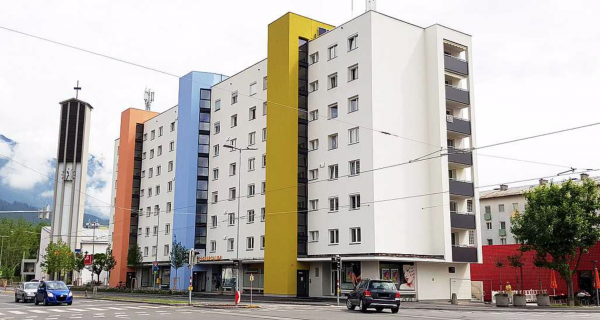Reichenauerstrasse
Name and Address
Name of the demo site: NHT IN40
Address of the demo site: Reichenauerstraße 62, 64, 66 in 6020 Innsbruck, Austria
Map
City map highlighting the surface occupied by the demo site (source: http://city-map.innsbruck.gv.at)
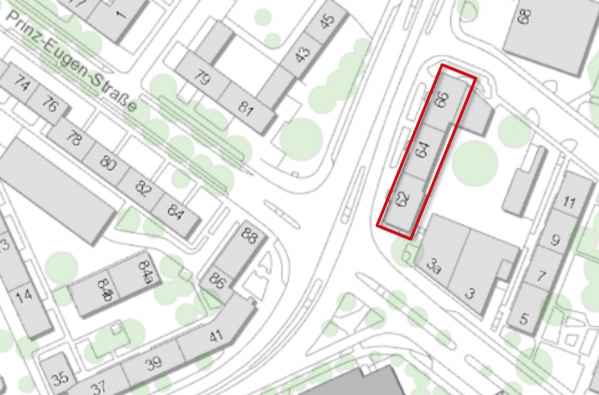
Description
NHT finished the innovative overall building renovation, consisting of the thermal renovation of walls, ceiling, roof and windows with triple-glazing. Existing balconies were demolished and replaced with new thermally separated ones. A central, flat-specific ventilation with heat recovery was integrated. The heating system is connected to the district heating network of IKB and was newly installed.
Ownership: Neue Heimat Tirol (NHT)
Gross conditioned floor area (EPC): 4,805 m²
Treated floor area (PHPP): 3,500 m² (without groundfloor)
Number of dwellings: 49
Heating demand (EPC)
BEFORE RENOVATION: 54 kWh/m²*a
AFTER RENOVATION: 22 kWh/m²*a
Heating demand (PHPP)
BEFORE RENOVATION: 81 kWh/m²*a
AFTER RENOVATION: 17 kWh/m²*a
Overall savings after completion of ventilation & heating system: >80%
All objects are patched via 1 long complex.
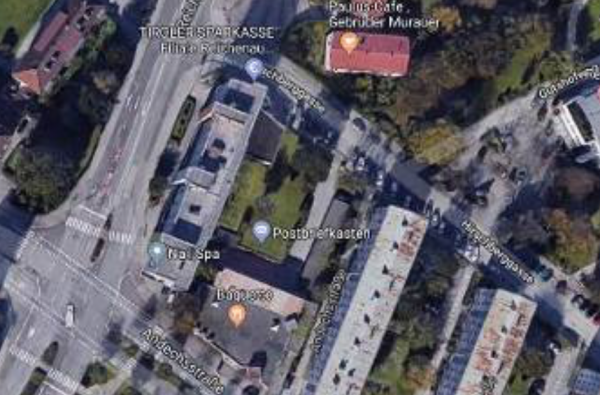
IN40 stock is a typical building block constructed in the second half of the 20th century with related challenges regarding insulation, electric cables, low performing windows, uninsulated roofs and cellars. The heating system is connected to the district heating network. The building was a Category C in terms of energy performance.
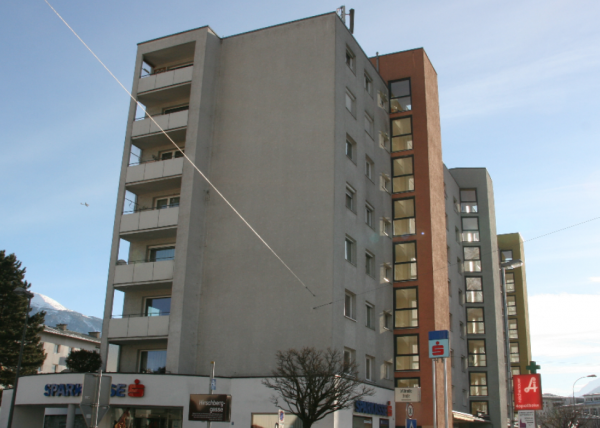
Technical system
Connected to the district heating network
Energy performance certificate
Category C
Concept
Thermal renovation of the walls, the ceiling, the roof and the windows with triple-glazing. Balconies were completely replaced by new thermal bridge-free ones. Decentralised, flat-specific ventilation with heat recovery was integrated.
Energy solutions
- The attics are insulated with additional 18cm XPS to the already existing 8cm-thick insulation,
- The facade is additionally insulated by 14 cm of mineral wool to the existing mineral wool of 6cm,
- Ceiling above the elevators is insulated with 18cm XPS to the already existing 5cm insulation,
- Ceiling to unheated basements additionally insulated,
- Balconies are completely replaced by a new thermal bridge-free construction,
- Distribution of the air via flat-specific, decentralised ventilation systems with heat recovery is designed in cascade-ventilation chain. 11 of the 49 flats are already equipped with the ventilation systems, the rest of the flats is prepared to be equipped with these systems in the event of a change of residence.
- The supply of space heating is handled by a central connection to the district heating of IKB. Within the apartments, radiators along with manually operated thermostats distribute the room heating.
- Old and inefficient DHW-boilers where replaced with modern well-insulated ones.
- The PV system was designed as a "tenant flow model". This means that the generated electricity is not only used by the residents individually in their flats but also serves to power the shared spaces of the property. Any remaining surplus is fed into the public grid. This model started in January 2018 - as a pilot project in the state of Tyrol
- Balconies are completely replaced with thermal-bridge-free new ones
- Partly replacing new triple glazed windows (55%) with app. 70 % better thermal performance. The rest are 10-year-old triple glazed windows (which are already equipped).
Envelope details
Roof to wall insertion section (thermal bridge)
- Insulation of the attic floor by using additional 18cm XPS (HFKW and HO free)
- Insulation of the ceiling above the elevators with additional 18cm XPS (HFKW and HO free)
Ground to wall section (thermal bridge)
- Ceiling to unheated basements additionally insulated
Wall to fenestration section (thermal bridge)
- Thermal insulation of façade (14cm of mineral wool in addition to the existing 6cm of mineral wool)
- Balconies are completely replaced with thermal-bridge-free new ones
- Partly replacing new triple glazed windows (55%) with app. 70 % better thermal performance. The rest are 10-year-old triple glazed windows (which are already equipped).
Performance targets
The target is to achieve a calculated energy consumption per m² of total used energy per conditioned floor area of about 34.8 kWh/m²*a (Space heating via district heating and DHW with electric hot water boilers).
Financing model
The refurbishment is financed via a mix of reserves as well as local/ regional/ national/ EU funding and includes an increase of the monthly rent.
Technical system
Mechanical ventilation
11 of the 49 apartments are equipped with flat-specific, decentralised ventilation systems with heat recovery. 22% of the building users are connected to the systems. All other apartments will be upgraded in the event of a change of residence.
Electric renewable integration
Nominal power of PV IN 13: 35.91 kWp, 240m² SOLARWATT modules
Mounting type: Roof mounted parallel
Elevation: 574 m a.s.l.
Tilt: 10°
Azimuth angle: 199°
Financial model: "tenant flow model" -a pilot project in the state of Tyrol
Stakeholders involved
Contracting authority: NHT Neue Heimat Tirol
Project manager: Gerda Maria Embacher
Architect/Envelope Designer: Architekt Vogl-Fernheim
Technical system designer: Klimatherm GmbH, Büro Ing. Obwieser Ges.m.b.H.
Construction company: KPS-Ötztal Putz, C. Günther, Strabag, Bodner, Rohner, Opbacher,
Windows supplier: Alutherm
Energy consultant, scientific support: University of Innsbruck and Passive House Institute – Department Innsbruck
Refurbishment costs
Total investment of € 3,36 Mio.
Work Progress
The challenges in the course of the refurbishment of residential buildings are complex and multi-layered. Financial and social aspects and challenges need to be considered, because the tenant has to co-finance some parts of the renovation, which requires the implementation of persuasion and tenant engagement activities. Furthermore, legal challenges also have to be solved. The most intensive persuasion is to be done in the field of nearly zero energy house renovation and, in particular, in cases where tenants are living in the flats during the time of ventilation system installations and other intrusive renovation activities.
Within SINFONIA, NHT has pushed the installation of controlled ventilation with heat recovery in IN40. For the time being, 22% of the building users have agreed to implement this measure. Further extension is expected according to the fluctuations of the building users and corresponding rental contracts with new tenants.
Architectonic concept
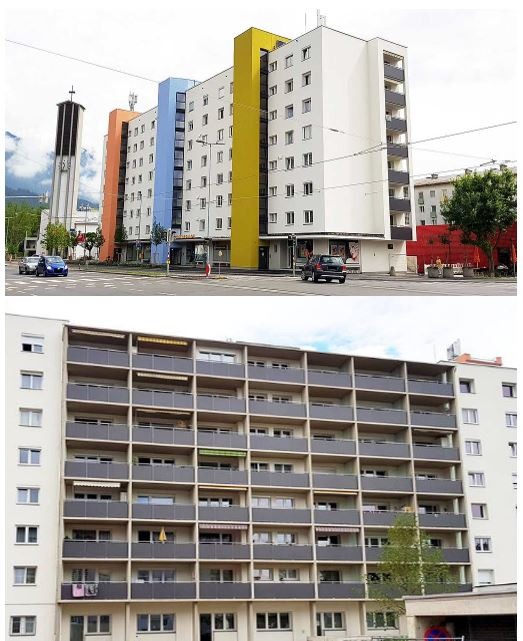
Prognosis for the renewable energy yearly yield: 37,741 kWh/a
End-Energy use (EPC): Calculated with 69,40 kWh/m²*a
Energy efficiency certificate (EPC): Category A
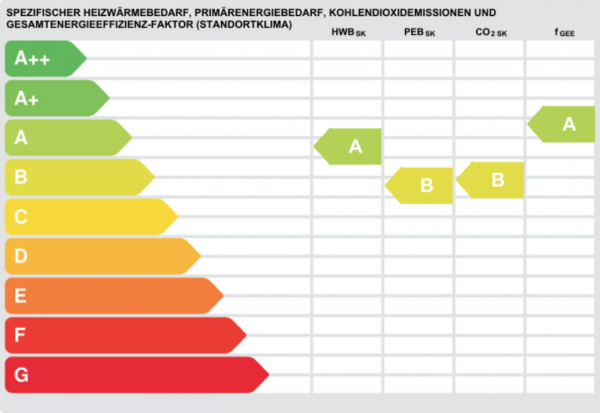
EnerPHit pre-certificate for stepwise refurbishment (PHI): EnerPHiT certification is foreseen shortly
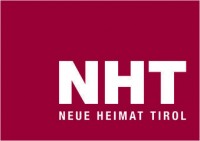
Building owner
Neur Heimat Tirol (NHT)
Architecture / Engineering
Architekt Vogl-Fernheim
Contact
Standortagentur Tirol
Tel : +43.512.576262
